Watching Letters from Iwo Jima reminded me that the atomic bombing of Hiroshima was 62 years ago today. I think Orac covers the moral and historical perspective of the bombings pretty well. What I wanted to talk about was the current city of Hiroshima.
I spent a year as an exchange student in Hiroshima University. I still get some odd questions when I say I stayed in Hiroshima. It seems some people think it’s something like the abandoned quarantine zone of Chernobyl (perhaps with added Godzilla). But in fact, by the time Americans entered Hiroshima less than two months after the bomb, radiation levels were barely above the US health guidelines for acceptable radiation exposure (well below the guidelines for occupational exposure). In any case, current radiation levels are indistinguishable from anywhere else in the world and the city is home to more than 1,100,000 people.
So now that that’s covered, I thought I’d list a few things worth doing and seeing in Hiroshima (it’s been a few years now so my apologies if anything has changed):
Okonomiyaki
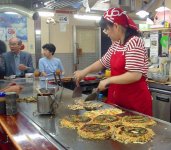
The signature dish of Hiroshima (it seems whenever you travel in Japan that trying the area’s food is as important as seeing the sights). Make sure you get the true Hiroshima-style with layers of crepe, cabbage, meat, noodles, egg, sauce, sea weed and fish flakes. I recommend asking for mochi (pounded rice cakes) too. Watching them cook on the hot griddle right in front of you is half the fun (although [thankfully] there aren’t any Japanese steakhouse theatrics).
The best place to have okonomiyaki is in Okonomi Village, with about 25 different Okonomiyaki stalls in one building. It’s really something to see 3 floors of stores all selling the same thing and trying to attract the customers. It’s right near the central shopping center of Hiroshima so it’s pretty convenient (map). (By the way, if anyone knows anywhere to get okonomiyaki in the US or Canada, let me know. I haven’t found it anywhere.)
Miyajima
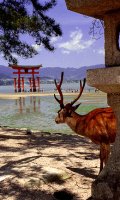
Japanese are big fans of ranking and the ‘floating’ arch of Itsukushima Shrine on Miyajima Island is listed as one of the top three most beautiful places in Japan (it’s also a World Heritage Site). The beauty of the arch is a bit decreased by the urban sprawl across the water (and the fact that it’s an arch stuck in the mud) but the whole island is pretty cool to walk around and see all the shrines and temples. There’s a really nice walk to the top of a mountain with a rewarding view (and sometimes wild monkeys) or if you’re less hiking-inclined you can take a cable car to the top. The friendly deer are also neat although not if you have anything edible (including maps) on your person.
Speaking of eating, the famous food from Miyajimi is momiji manju (I told you food was important), maple leaf-shaped waffle-like creations with centers filled with red bean paste or other deserts. It’s worth getting a fresh one if you are there.
Street cars
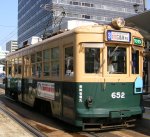
There’s something special about riding a trolley around a city and Hiroshima is one of the few cities left with street cars. They’re really convenient and they can take you from the main train station to the shopping center/Okonomi-mura area (also walkable) or to the ferry to Miyajima Island (a fair distance out of town). Although I didn’t know it when I was there, a couple of these cars are from before the war so it’s almost like riding in a museum (#651 and 652 according to Wikipedia). They’re also pretty cheap.
Hiroshima Castle Himeji Castle
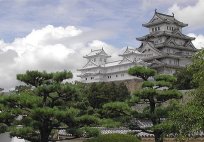
Although interesting if Hiroshima is the only place you are visiting in Japan, I think Himeji Castle which lies on the bullet train route between Hiroshima and the rest of Japan’s major cities is much more interesting than the reconstructed Hiroshima Castle. Himeji is ranked one of the top three castles in Japan (told you they liked rankings) and is a World Heritage Site. The castle was constructed in 1601 and never attacked (it’s three moats and mazelike entryway may have contributed to that). If you want to get in the mood before your visit, I recommend watching Kurosawa’s Ran, which was filmed in Himeji. Don’t forget to look for the haunted well of Okiku the Maid.
Mitaki Temple

This one I don’t think you’ll find in guide books. In fact, I was surprised to find Wikipedia had an entry for it. Some Japanese friends showed me this one and I really enjoyed it, especially since it’s off the beaten tourist trail. To get to Mitaki Temple take the Kabe Line from Hiroshima Station to Mitaki Station (an interesting example of the more rural stations with no staff, or buildings for that matter). Once you get off the train, walk up the road (map) to the beginning of the foot path to the temple. You’ll pass a cemetery on the way where it’s kind of interesting to see the difference between Western and Japanese grave markers.
Once you get to the temple grounds, it’s a nice uphill walk past several temples, waterfalls (Mitaki means 3 waterfalls) and statues. Once you get to the topmost temple, you can continue walking behind it to pass through some bamboo forest (e.g. Crouching Tiger) and eventually end up on a mountain top with a great view of Hiroshima City.
Sake Festival

If you’re going to be there in October (October 15th this year), the Sake Matsuri (Festival) in Saijyo, about a half hour east of Hiroshima City, is pretty fun. Saijyo is one of top two places for rice wine making in Japan. On this weekend, all the breweries open up and give tours. Like almost every festival in Japan, there is drumming and parades with people carrying around big heavy floats during the day. There are also tasty snacks like dough balls with octopus inside and squid on a stick. In the evening, they cordon off a big area and for about $10 you can sample as much sake as you want from about 1000 different types. You’ll never look at sake the same way again. The good sake goes quick so get there early.
Peace Park
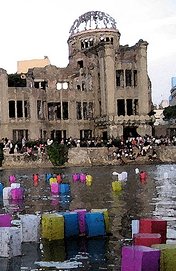
I left this until the end because it’s what most people think about when they hear Hiroshima but I wanted to point out that it’s not the only thing. That said, although it’s hard to talk about in the tourist sense, the park is definitely a must visit. Before you get to the park, a site that really brings home the recovery of Hiroshima is the center of the blast, indicated only by a small stone marker on the sidewalk between a multistory parking garage and a hotel (map).
The most famous part of the park is the Genbaku Dome, a building that managed to partially survive the explosion and was left as it was to serve as a memorial. It’s a World Heritage Site and seems to be the most photographed scene in Hiroshima but I really found some of the other parts of the park more moving (which perhaps is also why people find it easier to photograph the dome). The Children’s Peace Monument dedicated to children who died from the radiation and in particular Sadako Sasaki, a girl who folded 1000 paper cranes in the hope that it would help cure her cancer, is also on the grounds. A Cenotaph containing the 250,000 names of those who died from the bomb and its aftereffects and the Peace Museum showing the horrors of that day continue the somber tour. The most striking part of the park for me was a simple grass mound with a plaque beside it explaining that contained within were the ashes of 70,000 unidentified people.